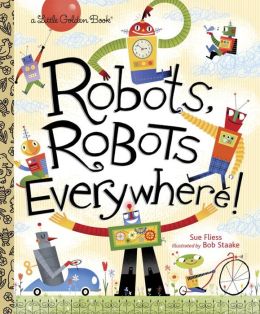I had a new student in speech this week. When I went to his classroom to pick him up for his first session, I called his name and he shrank. His shoulders rolled forward, he tucked in his chin and tried very hard to disappear into the crowd of kindergartners sitting on the carpet at their teacher’s feet. I gave him what I thought was an encouraging smile but it wasn’t encouraging enough—his eyes widened in apprehension, then melted into a pleading look as he turned toward his teacher, obviously hoping she’d rescue him. She didn’t. But she introduced us and reassured him that a lot of kids love going to speech. After I spoke a few kind words and found a friend to walk with him, he left with his new speech group and trudged along to my classroom.
Fortunately, I had an enticing book on my desk, just waiting for the right moment and a fitting group of kids for its introduction. I’d found both, so I scrapped my original plans and grabbed Robots, Robots Everywhere! by Sue Fliess, illustrated by Bob Staake.

I thought the cheery illustrations and catchy rhymes might help this new student forget his nervousness. I was right; the worry lines on his forehead softened the moment he looked at the cover of the book and they disappeared entirely by the time I’d finished reading a few pages,
On the ground
and in the air,
Robots, robots
everywhere!
Up in space,
Beneath the seas,
Robots make discoveries.
I’d forgotten how appealing robots are to young children. The kids moved in close to examine each illustration. Soon, this reluctant child leaned against my side so he could get a better look at the pages. It wasn’t long before he was pointing and laughing and talking about the kind of robot he wants to own. All of the kids had ideas to share. Jose wants a double-headed robot that climbs trees. Olivya wants a pumpkin-robot that glows. Enrique wants a tiny one “about this big” he circled his hand around a walnut-sized pocket of air. His robot will go on water, land, and in the sky.
My students made a scavenger hunt out of the book and scanned the pages for familiar shapes—squares, circles, rectangles, triangles, ovals, and ice-cream-cone-shapes. Their enthusiasm was contagious. I snatched my box of paper-scraps and quickly cut out a few similar shapes. We made collages, building our own robots as we built vocabulary.
I’ve known for a while, knowledge of shapes is an important foundation for growing math skills, but I was curious about its place in the curriculum so later in the day, I searched the Common Core Standards to find out where it’s listed. Sure enough, the first two kindergarten geometry standards require students to learn the names of various shapes. Our vocabulary lesson and Ms. Fliess’ book was a perfect fit for these kindergarten mathematicians.
The next day, when I went to pick up my new student, he practically bolted from his classroom. He could hardly wait to see if his robot collage was dry. He didn’t trudge to my room; he scurried along on imaginary robot feet, smiling all the way. It was no surprise to me. Over and over, I’ve seen what an appealing book can do to reach a reluctant child, whether it is a reluctance to leave a familiar environment, face a challenge or learn a new skill; books often ease the way into comfort and open minds to learning just as Robots, Robots Everywhere! did for this student.

How wonderful that this fun book could do so much for your new student! I am sure my 7-yr-old would enjoy it. He claims he is going to be a "robot scientist" when he grows up.
ReplyDeleteI'm pretty sure we need more "robot scientists" in the world. I bet your son will enjoy this book.
Delete